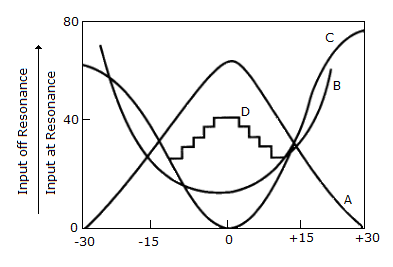Radio Receivers problems
- 1. RF amplifiers are used in radio receivers for
Options- A. better sensitivity
- B. improved signal-to-noise ratio
- C. better coupling of receiver to the antenna
- D. all of the above Discuss
Correct Answer: all of the above
- 2. The selectivity curve of a standard receiver is represented by

Options- A. curve A
- B. curve B
- C. curve C
- D. curve D Discuss
Correct Answer: curve C
- 3. In a receiver, which of the following device has RF input but IF output?
Options- A. Loudspeaker
- B. Frequency changer
- C. Demodulator
- D. Audio amplifier Discuss
Correct Answer: Frequency changer
- 4. Fidelity of a receiver represents
Options- A. the sensitivity expressed in terms of voltage that must be applied to the receiver input to give a standard output
- B. the extent to which the receiver is capable of distinguishing between the desired signal and other frequencies
- C. the variation of the output with the modulation frequency when the output impedance is a resistance
- D. none of the above Discuss
Correct Answer: the variation of the output with the modulation frequency when the output impedance is a resistance
- 5. A receiver having an RF amplifier and an IF of 450 kHz, has Q of the coils 65 and an incoming frequency of 1200 kHz. The image rejection of the receiver is
Options- A. 5870
- B. 3655
- C. 236
- D. 13.3 Discuss
Correct Answer: 236
- 6. The source of which of the following noise is different from that of the remaining?
Options- A. Solar noise
- B. Cosmic noise
- C. Galactic noise
- D. Atmospheric noise Discuss
Correct Answer: Atmospheric noise
- 7. The sensitivity of a superheterodyne receiver is determined by
Options- A. the gain IF amplifier
- B. the gain of RF amplifier
- C. the noise figure
- D. all of the above Discuss
Correct Answer: all of the above
- 8. In a superheterodyne receiver, the IF stage has better selectivity than RF stage because
Options- A. of higher frequency
- B. of lower frequency
- C. of high L/C ratio
- D. of constant passband Discuss
Correct Answer: of constant passband
- 9. An unmodulated voltage 10 V effective is applied to a dioxide detector in which load resistance is 4 x 10-5 ohms. A micrometer shows that the rectified DC current in this resistance is 30 A. The efficiency of detection is
Options- A. 34%
- B. 55.5%
- C. 68.8%
- D. 84.7% Discuss
Correct Answer: 84.7%
- 10. The problem associated with tuned-radio frequency receiver is
Options- A. instability
- B. insufficient adjacent frequency rejection
- C. bandwidth variation
- D. all of the above Discuss
Correct Answer: all of the above
More in Electronics and Communication Engineering:
Programming
Copyright ©CuriousTab. All rights reserved.
